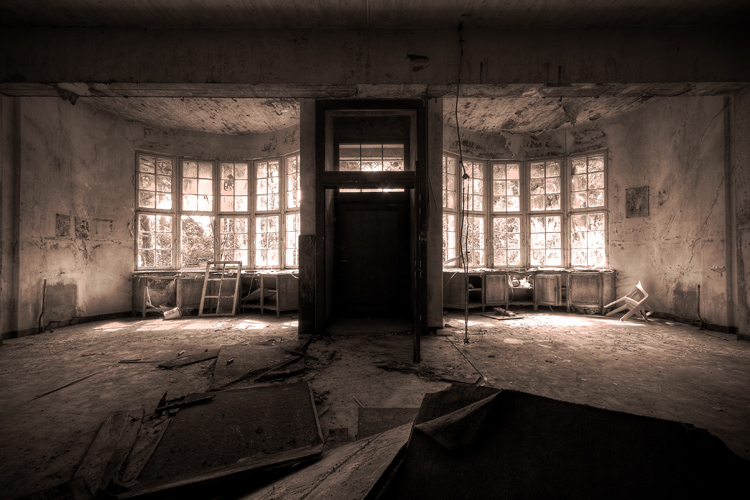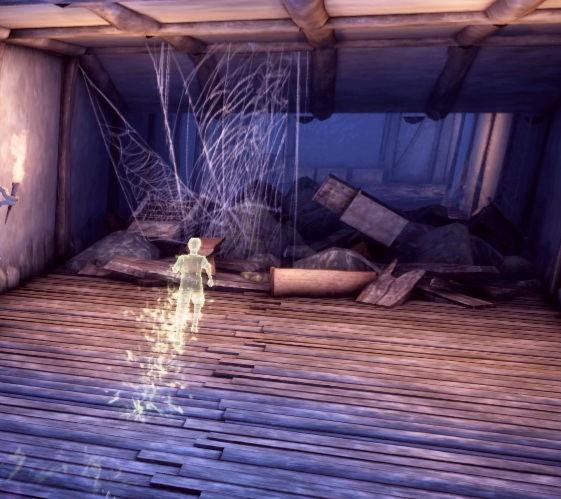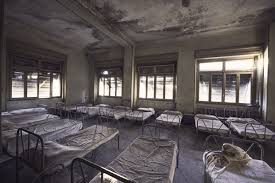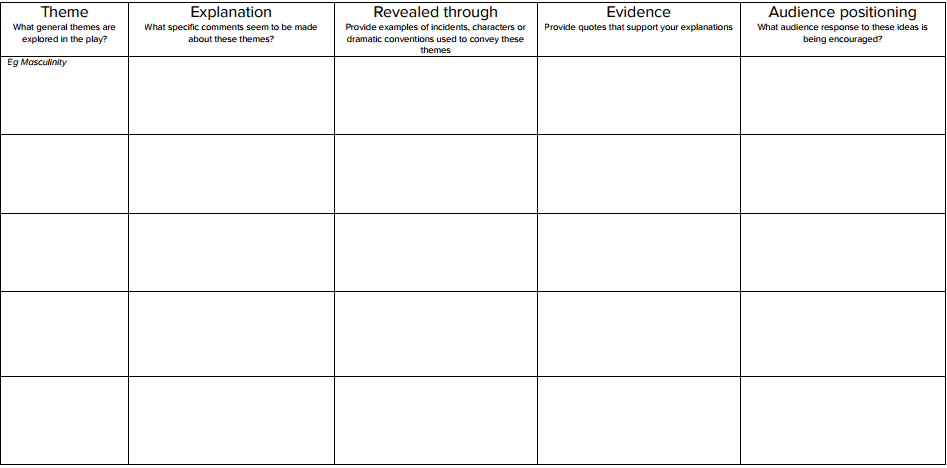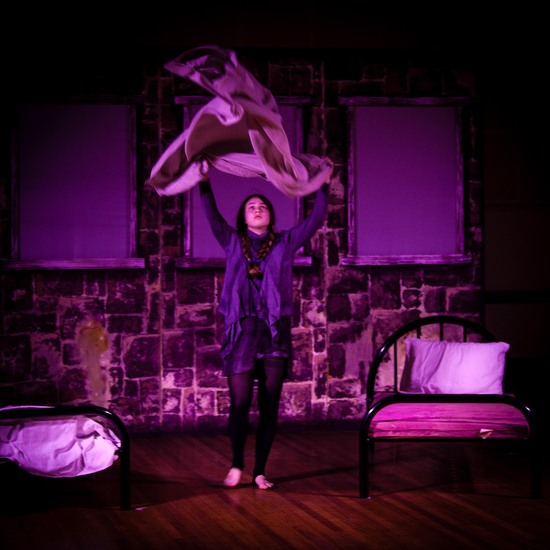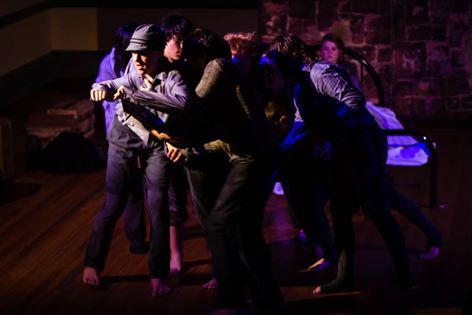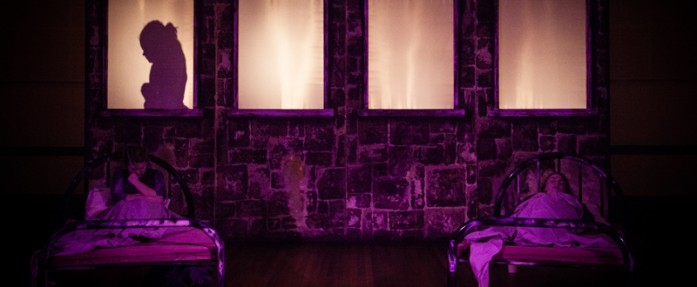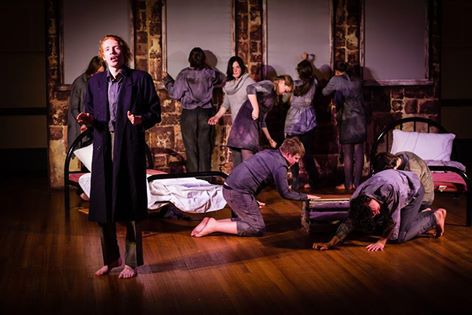AustLit
-
The unit of work below has been created to study Children of the Black Skirt, by Angela Betzien. The work covers both practical and theory elements which allow students to build on their knowledge throughout the unit. The lesson plans are purely examples which are adaptable and have the ability to be re-worked to meet specific class needs and circumstances.
-
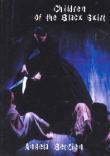 This image has been sourced from online.See full AustLit entry
This image has been sourced from online.See full AustLit entryThree lost children stumble across an abandoned orphanage in the bush. they become trapped in a timeless world, haunted by spirits from the past. They are tormented, too, by the black skirt, a cruel governess who floats up and down the orphanage corridors wielding enormous scissors. But as the stories of these forgotten children are told - from pickpocketing incidents in the eighteenth century to the tragedies of the Stolen Generations in the twentieth - their spirits are released, one by one.
(...more)Characters
Lost Bush Children (3)
New One
Old One
The Black Skirt or Miss Emily Greenant
Rosie
John
Lizzie
Maggie
Lucy
Harrold Horrocks
Iris
Tom
Ruby
Baby
Gentleman, Banker, Beggar, Magistrate
Lizzie's Mother
Maggie's Mother, Father
Nun, Mrs Connell
Iris's Dad, Landlord, Neighbour
Fat Man, Tom's Mother
Ruby's Mum, Welfare
The Black Skirt's Aunt, Doctor
NOTE: These characters can be played by three actors
Themes
Abandonment
Poverty
The Stolen Generations
Child Abuse
Child Migration
Spirits
Power
Setting
An Abandoned Orphanage
Angela Betzien's website link for Children of the Black Skirt.
-
The aim of this stage is to gain an initial idea of student knowledge. The activities below will assist knowledge building and act as a primary point of reference for the play.
Introductory Activity
Explore an Orphanage Setting:
Consider the following images to gain an insight into student learning. The questions will allow students to develop an understanding about the basic of the setting before beginning the play text.
1. What do you feel?
2. What are your thoughts about the overall image?
3.What particular associations do we have with orphanages? Think about stories, people, events or themes.
4. From what you have learnt about Gothic Theatre so far, why would orphanages have a strong relationship with the Gothic?
-
For further general image searches, explore the following site recommendations.
Introducing the Context
Book a lesson in the computer lab. Allow students to search about Children of the Black Skirt. As a starting point for the students, provide the following resources:
Ask students to find another source that isn't listed above to bring to the next class for share time.
Personal Response to Children of the Black Skirt
Set one class aside to read Children of the Black Skirt. After reading the play, ask students for homework or as an in class activity to write a critical reflection by drawing upon the play, the activities completed prior and their own thoughts on the text. Use student responses for a classroom discussion to start formulating mind maps/tables/wordles of characters, plot points, themes and motifs of the play.
Key Elements of the Text
Plot
- Ask students to work as a group to create a plot timeline of the text. Include main events, stories and important aspects that make the story what it is. In the following class, take students to a computer lab to research information about the specific moments in the play. For example - The Stolen Generations. Students will then create in groups, a poster that informs the class of the historical information, the impact on the play and the accuracy of the representations of the event/story.
- You've being approached by the school principal to present the class work in a visual representation on the school's main Facebook page. Ask students to re-create the main parts of the play in a visual representation and photograph the image they create. Ask students to write a brief caption that best suits the photo that was taken.
NOTE: Seek permission from parents/caregivers for photography and social media rights.
Character
- Choose one character from the play. Perform a Gothic inspired piece (improvisation or rehearsed) that highlights new information, detail or characterization of the character. This should not affect the overall context of the play nor the story line.
- Think critical of the characters Old One and New One and the characters they switch into during the text. Is there a relationship to the characters they switch too? Is there a hidden relationship that Betzien wanted to create? Discuss.
Themes
- Ask students to choose one theme of the play. Students are to take the theme they chose and place it in a different situation that differs completely from the text. While rehearsing this scene, get students to think about the effect of the theme? While taking Gothic themes, do they still have the same affect if it were a comedy/romance? If yes, how? If no, why - provide examples?
- Ask students to choose 3-4 themes they can relate to. Using the table below, allow students to break down the theme per row and complete what they can of the table.
-
The aim of this stage is to dig deeper into critical thinking, exploration and understanding of the play. Students will draw on their own interpretation and will also concentrate on the hidden messages in the text.
Semiotics of Drama
- Voice: The Delivery of Dialogue – dynamic range, intonation and vocal quality.
- Sound design: The meaning and effects of diegetic and extra-diegetic sounds and music.
- Costume: The appropriateness to the individual character.
- Set design: Consider the use of space vertically/horizontally, colour, mass, texture, flexibility. The conveyed meaning to be explored.
- Lighting: How it is used - realistically/symbolically, passively/dynamically? Consider the relationship to the staging, characters, overall aspect of the play.
- Proxemics: The spatial relationships between actors, actor to set/prop and how it contributes to the meaning.
- Kinesics: The movements of actors and how do they establish character. Furthermore, how is it related to the overall factor of the play.
Consider the below images from the Adelaide Production in 2015 and the RealTV production highlights video. Either as a class, in small groups or individually, discuss the similarities and differences in the understanding to that of the original text. Provide reasoning and specific examples from both text and visual aid in relation to the semiotics above. Be precise as possible and ensure visuals are analysed critically and in a reflective manner. If the students close study of visual aids are not what they expected or interpreted, ask them to show/describe how they would portray the scene.
-
-
To further the close reading skills of the class, select one or as many as needed of the below and get the class to think both critically and reflectively about Children of the Black Skirt.
Symbolism
- Throwing of the sheet to release spirits
What could throwing the sheet represent?
Do sheets and spirits have a mythical connection?
Is this an artistic choice/development?
Is there research to assist in the decision making?
Is there a hidden meaning within the text?
- Black Skirt (the skirt, not the character)
Is it simply just what the head of the orphanage would wear?
What is significant about the colour Black? Think about representations and signifiers.
Is the skirt, what makes the Black Skirt powerful? Would it be different if it wasn't black (would it have the same effect?)
What else does the skirt represent as a symbol?
Storytelling
- Stories
What is Gothic about the stories?
How does each story relate to the overall themes/plot of the story?
Taking the structure of the play, would it be more effective to use physicality to explore the stories or will translations of the story be lost without words?
What is common amongst the stories? Any similarities or are they their own unique story?
- Letters
Discuss the importance of the letters to the overall play. Why structure the play to have the letters where they are?
What do the letters reveal about each child?
Are we able to assume a background to each of the children, in regard to the specific themes of the play (e.g., a sense of Child Migration, The Stolen Generation)?
Physicality
- Stage Directions
Is the piece successful as a physical piece? Would you say, the intention of the playwright was met?
In using movements, is there anything that is lost or unanswered in the play?
Why use physicality? Is it an easy way to explore Gothic? Is there any connections or hidden meanings?
- Embodiment of Characters
What do you think is the purpose of Old One and New One embodying the characters? Is it simply artistic or is there a hidden meaning?
By embodying the characters, do Old One and New One hold any significance over other characters (e.g., Black Skirt, Horrocks, themselves)?
-
The aim of this stage is to understand the multiple perspectives and/or layers of the play. This will allow students to gain insight into its significance and idea that the play text offers in hindsight.
Three ways of Reading
There are multiple factors that are included within the play that assist readers with either interpretation, exact understanding or close reading opportunities. When broken down into main categories, a political, professional and personal reading can occur. Ask students to pick a reading lens, then select a sub-category and a question. More likely to be set over a week, ask students to write 200 words on the selection they have made.
Politically
- The Stolen Generations
- Colonial Australia
- The Depression
- Penal Transportation
- Post-war immigration
Discuss the above in regard to local, national and international? How does each location change in regard to the political reading of your choice? e.g., What difference would The Stolen Generation have in a local Indigenous community to that of an American community?
Professionally
- Black Skirt (as a character)
What are the objectives of the Black Skirt? How does her presence impact the play?
Discuss symbolism in regard to the character (scissors, black skirt etc).
Does the Black Skirt have power? Provide examples and close reading analysis to back-up your claim.
- Horrocks
Describe how Horrocks dictates his authority in the play.
How is Horrocks positioned in regard to Aboriginality in the play? Use further research to help justify your response.
Personally
- Childhood
What is a child? Is it different to what is evident in the play?
How has the events of the past affected every day life for children in the 21st Century?
NOTE: If preferred, give students the opportunity to write their own question in correspondence with you as the classroom teacher.
-
The aim of this stage is to finalise and expand on information and knowledge taught throughout the unit of work. This stage is most useful for assessment purposes and therefore, would allow teachers to assess students ability and comprehension of Children of the Black Skirt.
Forming
Ask students to select a section of the text. This assessment can be either in small groups or individually. Students are to take the section they have chosen and create a set design and costume for the characters involved. They will present their work in a 5-6 minute presentation that explains in detail what they have designed. The presentation should include: the staging design, costumes (students to wear their design), why they have chosen what they have (both for artistic and theatrical purposes) and a justification from sources/information/learning material, specifically drawing on the Gothic Theatre style and the play text Children of the Black Skirt.
Presenting
Ask students to choose a theme that has previously been discussed. Furthermore, pick a section of the play that includes, somewhat, of an even amount of stage directions and dialogue that best summarises the selected theme. The student's task is to create a 5-6 minute presentation in small groups that switches dialogue to actions and actions to dialogue. Every member must be included in the performance. Encourage students to take a risk with the creative elements. Keep in mind that students MUST remain within the boundaries of the performance space and the performance text.
Responding
Ask students to write a 600-800 word essay that answers the following question:
- How does Children of the Black Skirt play with society and personal norms within the play? Provide examples from the text and place these into conversation with further examples from history and the modern day.
Please Note: These are only examples and can be altered, changed and/or adapted to individual teaching needs.
-
The above class work and assessment will allow students from Grade 10 and above to meet the requirements of most, if not all, content bands and descriptors listed within the national curriculum. Below is the standard that students of Grade 10 must meet in order to receive a passing mark.
"By the end of Year 10, students analyse the elements of drama, forms and performance styles and evaluate meaning and aesthetic effect in drama they devise, interpret, perform and view. They use their experiences of drama practices from different cultures, places and times to evaluate drama from different viewpoints.
Students develop and sustain different roles and characters for given circumstances and intentions. They perform devised and scripted drama in different forms, styles and performance spaces. They collaborate with others to plan, direct, produce, rehearse and refine performances. They select and use the elements of drama, narrative and structure in directing and acting to engage audiences. They refine performance and expressive skills in voice and movement to convey dramatic action." (ACARA).
You might be interested in...



